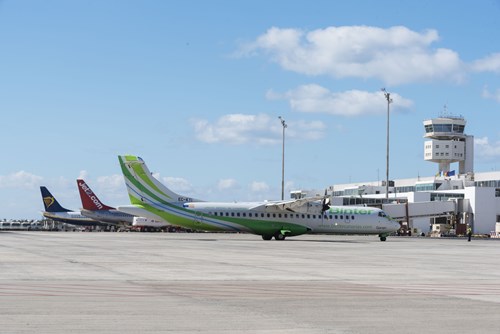ENAIRE and Aena improve operations at two airports with new satellite navigation procedures

ENAIRE, the national air navigation service provider, and Aena, the airport manager, have improved operations at the La Palma Airport with new satellite-based approach procedures at both runway thresholds, RWY 18 and RWY 36, the latter of which includes an approach that relies on the European EGNOS satellite system.
By implementing these new procedures, ENAIRE and Aena are increasing the efficiency of operations, as well as accessibility to the airport. Since these procedures do not depend on ground-based navaids, they provide a very useful solution as an improvement or alternative to the current conventional approaches, although flying these satellite-based navigation procedures does require aircraft to be specially equipped, and crews to be trained on their use.
In the case of the runway 36 threshold, instrument approach procedures with vertical guidance on final approach are being introduced for the first time at the La Palma Airport, which improve the pilot's situational awareness and facilitate a stabilised descent for landing.
The recent implementation of these new procedures on the island of La Palma is in addition to those already in place at the airports of Josep Tarradellas Barcelona-El Prat, Jerez, Seve Ballesteros- Santander, Almería, Valencia, Fuerteventura, Palma, César Manrique-Lanzarote, Vigo, A Coruña, San Sebastián and others as part of ENAIRE's Plan to Implement Performance-Based Navigation (PBN) Procedures.
This process to implement satellite-based navigation approach procedures will help to further comply with the Performance-Based Navigation (PBN) Implementation Plan, which is in turn part of ENAIRE's Strategic Plan, its 2025 Flight Plan. It also assists in complying with European Commission Implementing Regulation (EU) 2018/1048, the aim of which is to improve the
efficiency of air traffic management at the European level by implementing performance-based navigation (PBN).
In order to allow these new landing procedures to go into operation, ENAIRE has conducted the necessary safety studies, which were duly processed with the National Aviation Safety Agency (AESA).
European EGNOS System
The use of the European EGNOS satellite navigation system, which is owned by the European Union Agency for the Space Programme (EUSPA), is part of the service agreement already in place between ENAIRE and ESSP, the company that provides the EGNOS service.
ESSP is an air navigation provider supervised by the European Aviation Safety Agency (EASA) and owned by ENAIRE, together with air navigation providers from Germany, France, Italy, Portugal, the United Kingdom and Switzerland.
Through this effort, ENAIRE and Aena are making available to users of the La Palma Airport satellite-based approach procedures that improve the safety and consistency of operations without the need to install additional ground facilities, with the cost savings and operational advantages this entails.
First Spanish company
On 27 January, ENAIRE became the first company in Spain to be certified as a provider of flight procedure design (FPD) services, in order to comply with the new European law, EU Regulation 2017/373, as laid out in its 2025 Flight Plan. This certificate authorises it to design, document and validate flight procedures, including maintenance and periodic review activities.
César Manrique-Lanzarote Airport
ENAIRE and AENA have also improved operations at the César Manrique-Lanzarote Airport
with new satellite-based approach procedures at the runway 21 threshold.

By implementing the satellite-based navigation procedure, ENAIRE and Aena are increasing the efficiency of operations, as well as accessibility to the airport. Since these procedures do not depend on ground-based navaids, they provide a very useful solution as an improvement or alternative to the current conventional approaches, although flying the satellite-based navigation
procedure does require aircraft to be specially equipped, and crews to be trained on its use.
It is worth noting that one of the two procedures that will be implemented, given the complexity of the location in terms of the surrounding terrain, includes a technical solution to line up with the runway by relying on a trajectory that uses predefined (prescribed) visual bearings, this improving
the safety of operations at the runway 21 threshold at the airport. This solution is similar to that used at the A Coruña Airport for the runway 03 threshold, which is currently in use.
The recent implementation of these new procedures for runway 21 at the César Manrique-Lanzarote airport is in addition to those already in place at the airports of Josep Tarradellas Barcelona-El Prat, Jerez, Seve Ballesteros- Santander, Almería, Valencia, Fuerteventura, Palma, Vigo, A Coruña, San Sebastián and others as part of ENAIRE's Plan to Implement Performance-
Based Navigation (PBN) Procedures. These kinds of procedures are already in place at the runway 03 threshold at the César Manrique-Lanzarote Airport. This process to implement satellite-based navigation approach procedures will help to further comply with the Performance-Based Navigation (PBN) Implementation Plan, which is in turn part of ENAIRE's Strategic Plan, its 2025 Flight Plan. It also assists in complying with European Commission Implementing Regulation (EU) 2018/1048, the aim of which is to improve the efficiency of air traffic management at the European level by implementing performance-based navigation (PBN).
In order to allow these new landing procedures to go into operation, ENAIRE has conducted the necessary safety studies, which were duly processed with the National Aviation Safety Agency (AESA).
Through this effort, ENAIRE and Aena are making available to users of the César Manrique-Lanzarote Airport satellite-based approach procedures at the RWY 21 threshold that improve the safety and consistency of operations without the need to install additional ground facilities, with the cost savings and operational advantages this entails.


.png)
.jpg)





Comments
There are no comments yet for this item
Join the discussion